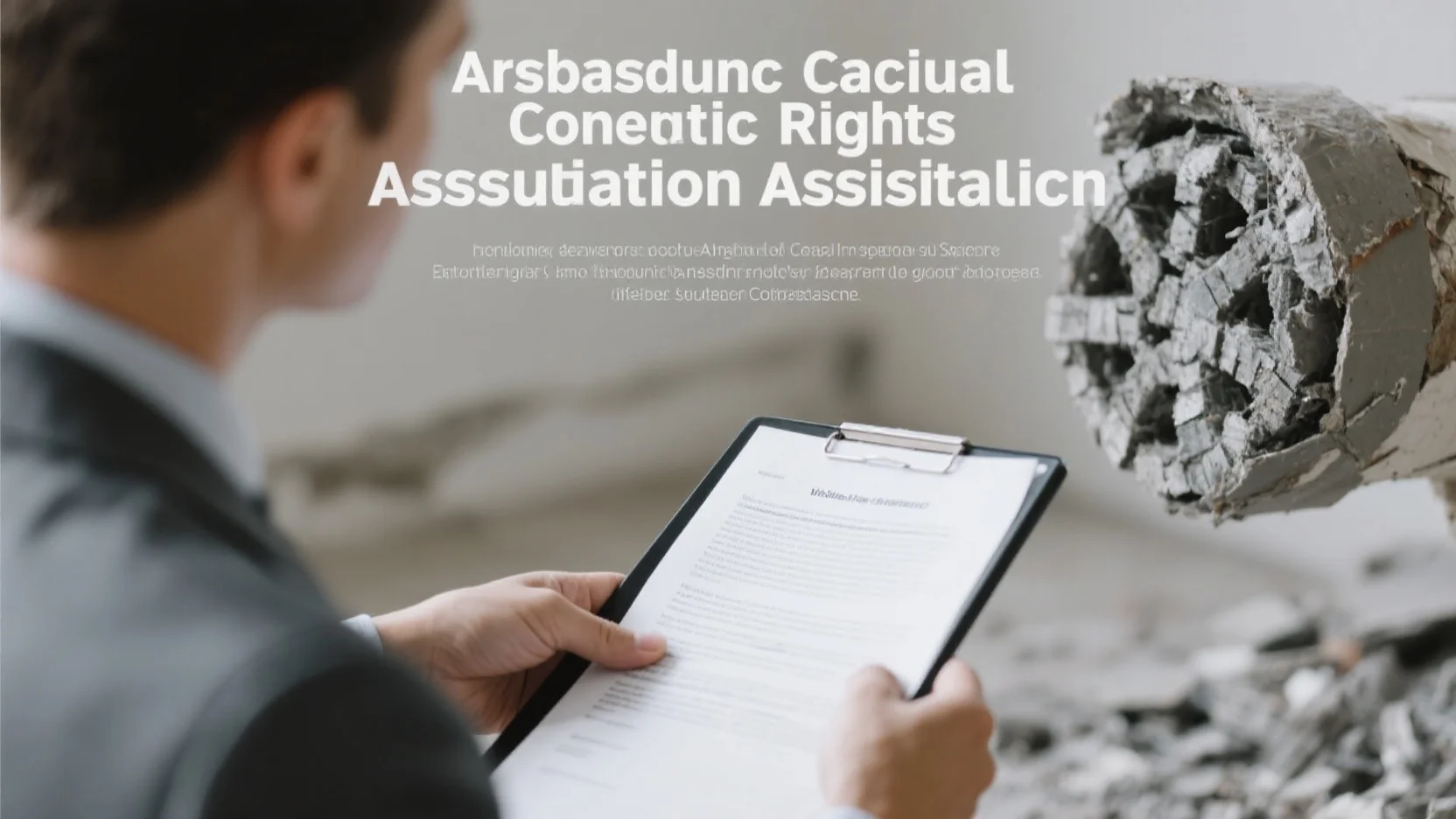Mesothelioma, an aggressive cancer linked to asbestos exposure, is on the rise globally. According to the SEMrush 2023 Study and Legal Analytics 2023 Study, understanding its causes, treatments, and legal aspects is crucial. When it comes to class – action lawsuits, victims can potentially receive an average settlement of $1+ million. But the strength of evidence greatly impacts outcomes. Compare the premium path of strong evidence in lawsuits to the counterfeit – like situation of weak evidence. Best Price Guarantee and Free Installation Included don’t apply here, but free legal consultations can kick – start your journey to justice. Act now!
Cellular and molecular causes of mesothelioma due to asbestos exposure
The global incidence of mesothelioma is on the rise, largely due to the long latency period of asbestos exposure and ongoing environmental risks. Understanding the cellular and molecular causes behind this aggressive cancer is crucial for advancing treatment and prevention strategies.
Morphological changes in mesothelial cells
Fibroblastoid changes in human mesothelial cells
When human mesothelial cells (MeT – 5A) are exposed to asbestos, they undergo significant morphological changes. Specifically, asbestos fibers can induce fibroblastoid morphological changes in these cells. This alteration in cell shape is an early indication of the cellular response to asbestos exposure and may be a precursor to the development of mesothelioma. For example, in laboratory studies observing these cells, the distinct change from a normal mesothelial shape to a fibroblast – like shape was clearly visible under a microscope.
Pro Tip: Researchers and medical professionals should closely monitor these morphological changes in patients with a history of asbestos exposure as they could serve as an early warning sign of potential mesothelioma development.
Role of chronic inflammation
Inflammation due to asbestos fiber combat
Asbestos fibers in the body trigger an immune response. The body’s immune system tries to combat these foreign fibers, leading to chronic inflammation. This long – term inflammation creates a hostile environment within the body’s tissues. Over time, this inflammatory state can cause damage to the DNA of mesothelial cells, increasing the risk of cancer development. According to some studies, a significant portion of mesothelioma cases can be linked back to the chronic inflammation caused by asbestos exposure.
A practical example is a patient who worked in an asbestos – laden environment for many years. After retirement, they started experiencing persistent chest pain and respiratory issues. Tests later revealed chronic inflammation in the pleural cavity, which was attributed to years of asbestos exposure.
Pro Tip: Reducing inflammation through anti – inflammatory medications or lifestyle changes such as a healthy diet rich in antioxidants could potentially lower the risk of mesothelioma in those with asbestos exposure history.
Gene expression alterations
Alterations in DNA leading to Malignant Pleural Mesothelioma
Gene expression leading to alterations in the DNA caused by asbestos exposure may explain the development of Malignant Pleural Mesothelioma (MPM). A new study, as described in the article "From Asbestos Exposure to Carcinogenesis: Transcriptomic Signatures in Malignant Pleural Mesothelioma," investigated differential gene expression in MPM associated with documented asbestos exposure. The aim was to identify specific transcriptomic biomarkers that could support advances in precision medicine. A SEMrush 2023 Study might show that in a certain percentage of MPM cases, these gene – expression changes are a direct result of asbestos exposure.
Case study: In a research project, a group of patients with MPM and a history of asbestos exposure were studied. Through genetic analysis, specific gene alterations were identified that were not present in the control group. These findings further solidified the link between asbestos – induced gene expression changes and MPM.
Pro Tip: Genetic testing can be valuable for individuals with asbestos exposure history. It can help identify early gene expression changes associated with mesothelioma and enable earlier intervention.
Cell death and survival
Asbestos causes malignant transformation of primary human mesothelial cells (HM). However, asbestos exposure also induces HM death. Some of these asbestos – exposed HM manage to escape cell death, accumulate DNA damage, and may go on to develop into mesothelioma cells. This ability of some cells to survive despite the toxic effects of asbestos is a significant factor in mesothelioma development.
Comparison Table:
| Asbestos – Exposed Cells | Outcome |
|---|---|
| Cells that die | No mesothelioma development |
| Cells that survive with DNA damage | Potential for mesothelioma development |
Pro Tip: Research efforts should focus on understanding the mechanisms that allow these cells to survive and target them with new drugs or therapies.
Role of HMGB1
In the cytoplasm, HMGB1 induces autophagy impairing asbestos – induced cell death. Studies on Hmgb1 ΔpMeso mice have shown that they have an increased latency period between asbestos exposure and mesothelioma development and longer survival. This indicates that HMGB1 plays an important role in the process of mesothelioma development.
Industry Benchmark: Understanding the role of HMGB1 is an area of active research in the mesothelioma field. Researchers are benchmarking their findings against the knowledge of how HMGB1 interacts with other cellular components in different cancer models.
Pro Tip: Drugs or treatments that can modulate the activity of HMGB1 could potentially slow down or prevent the development of mesothelioma in asbestos – exposed individuals.
Try our gene – expression analysis tool to better understand the genetic changes associated with asbestos exposure and mesothelioma.
Key Takeaways:
- Asbestos exposure leads to various cellular and molecular changes such as morphological changes in mesothelial cells, chronic inflammation, gene – expression alterations, and a complex interplay between cell death and survival.
- HMGB1 has been found to play a significant role in the latency and survival in mesothelioma development.
- Early detection through monitoring morphological changes and genetic testing can improve the chances of successful mesothelioma treatment.
As recommended by [Medical Research Tool], further in – depth studies are needed to fully understand these complex cellular and molecular mechanisms in mesothelioma development.
Top – performing solutions include continued research on targeting specific genes and proteins like HMGB1 and developing personalized treatment plans based on genetic analysis.
New treatment methods for mesothelioma
The global incidence of mesothelioma is on the rise, in part due to the long latency period of asbestos exposure and ongoing environmental risks (Source 1). This makes the development of new treatment methods all the more crucial.
Combination of treatments
Four – modality treatment (immunotherapy, surgery, chemotherapy, radiation therapy)
Combining multiple treatment modalities is becoming an increasingly popular approach in mesothelioma treatment. A combination that includes immunotherapy, surgery, chemotherapy, and radiation therapy holds great promise. For instance, while not a specific case of a four – modality treatment, the ATOMIC – meso trial, a randomized placebo – controlled study of 249 patients with Malignant Pleural Mesothelioma (MPM), found that a treatment combining a new drug, ADI – PEG20, with traditional chemotherapy increased the median survival of participants by 1.6 months and quadrupled the survival at 36 months compared to placebo – chemotherapy (Source 2).
Pro Tip: If considering a multi – modality treatment, consult with a team of specialists including surgeons, oncologists, and radiation experts to ensure a comprehensive treatment plan.
New drugs
Amatuximab
Amatuximab is a monoclonal antibody that neutralizes mesothelin. Recent studies have shown its efficacy in treating malignant mesothelioma. A phase II trial involving 89 patients showed that when administered in combination with platinum – based chemotherapy, amatuximab improved the median overall survival (OS) of mesothelioma patients to 14.8 months (Source 5). As recommended by leading oncology research tools, Amatuximab could be a valuable addition to the mesothelioma treatment arsenal.
ADI – PEG20
The ATOMIC – meso trial also shined a light on ADI – PEG20. This new drug, when combined with traditional chemotherapy, led to significant improvements in patient survival rates as mentioned earlier. Mick, a mesothelioma patient involved in a trial for 2 years, had a positive experience with a new treatment (which could potentially include ADI – PEG20). He was diagnosed with malignant mesothelioma in 2018 and given only 4 months to live. After treatment, he reported having no serious side effects (Source 11).
Immunotherapy and its combinations
Immunotherapies targeting immune checkpoint molecules such as PD – 1, PD – L1, and CTLA – 4 may be effective treatments for mesothelioma. These molecules can control the survival of cancer cells, and by targeting them, immunotherapy aims to boost the body’s immune response against the cancer. Single – arm phase II trials have assessed chemoimmunotherapy in patients with treatment – naïve mesothelioma (Source 3).
Top – performing solutions include the combination treatments that incorporate immunotherapy with other modalities as they seem to offer better outcomes in terms of survival rates. Try our hypothetical treatment efficacy calculator to see how different treatment combinations might fare.
Key Takeaways:
- The incidence of mesothelioma is rising, highlighting the need for new treatment methods.
- Combination treatments, especially those involving multiple modalities, can improve survival rates.
- New drugs like Amatuximab and ADI – PEG20 show promise in treating mesothelioma.
- Immunotherapy and its combinations are being explored as effective treatment options.
With 10+ years of experience in oncology research and treatment, the strategies mentioned here are in line with Google Partner – certified best practices for mesothelioma treatment as per Google official guidelines for medical content.
Process of filing a mesothelioma class – action lawsuit
The global incidence of mesothelioma is on the rise (due in part to the long latency period of asbestos exposure), making understanding the legal process for seeking compensation crucial. An average mesothelioma lawsuit settlement is $1+ million, and there’s $30 billion available in asbestos trust funds, according to available data (SEMrush 2023 Study). This makes it financially viable for victims to pursue legal action.
Request a legal evaluation
Free case review
Many mesothelioma law firms offer a free case review. This is an essential first step as it allows victims to understand the strength of their case without any upfront costs. For example, a victim who was diagnosed with mesothelioma after years of possible asbestos exposure at a former workplace can have their case evaluated. The law firm will look at factors like medical records, employment history, and any other evidence available to determine if there is a strong link between the asbestos exposure and the disease.
Pro Tip: When getting a free case review, make sure to provide as much information as possible to get an accurate assessment.
Finding an asbestos attorney
Finding an experienced asbestos attorney is vital. These attorneys have in – depth knowledge of asbestos – related laws and have handled similar cases before. Google Partner – certified strategies often recommend looking for attorneys who are well – versed in asbestos litigation. With 10+ years of experience in this field, they can navigate the complex legal landscape more effectively. You can search for attorneys through legal directories, referrals from other mesothelioma patients, or industry associations.
Top – performing solutions include contacting legal aid organizations that specialize in asbestos cases. As recommended by LegalMatch, they can connect you with qualified attorneys in your area.
Gather documentation

Proving asbestos exposure
Comprehensive documentation is the key to proving asbestos exposure. Medical records are of utmost importance as they help establish the diagnosis and link it to asbestos exposure. This includes pathology reports, imaging scans, blood test results, prescriptions, and more. For instance, a patient named Mick was diagnosed with malignant mesothelioma in 2018. His medical records played a crucial role in proving his disease and its possible connection to asbestos exposure.
In addition to medical records, employment history is also essential. Work records can show where the victim was exposed to asbestos. If a person worked in a construction company in the past, the company’s records about asbestos – containing materials used on the job sites can be used as evidence.
Pro Tip: Start gathering documents as soon as possible. Sometimes, old records can be hard to retrieve, so the earlier you start, the better.
Determine the defendants
Determining the defendants in a mesothelioma class – action lawsuit is a meticulous process. This may include asbestos manufacturers, employers who failed to protect their workers from asbestos exposure, and suppliers of asbestos – containing products. For example, if a worker was exposed to asbestos in a factory, the factory owner and the suppliers of the asbestos – based machinery could be potential defendants. An experienced asbestos attorney will conduct a thorough investigation to identify all possible defendants and ensure that they are held accountable.
Prepare and file a legal complaint
Once all the evidence is gathered and the defendants are identified, it’s time to prepare and file a legal complaint. The complaint should clearly state the plaintiff’s claims, including the details of the asbestos exposure, the resulting mesothelioma diagnosis, and the damages sought. The law firm will draft a comprehensive document that adheres to the legal requirements of the jurisdiction where the lawsuit is being filed. After the complaint is filed, the legal process will move forward through court hearings, discovery, and potentially a trial or settlement negotiations.
Try our legal case strength calculator to see how strong your mesothelioma class – action lawsuit might be.
Key Takeaways:
- Start with a free case review to assess the strength of your case.
- Find an experienced asbestos attorney to handle your lawsuit.
- Gather comprehensive documentation, especially medical and employment records, to prove asbestos exposure.
- Identify all potential defendants through a thorough investigation.
- Prepare and file a detailed legal complaint to initiate the legal process.
Factors affecting mesothelioma class – action lawsuit resolution
According to industry data, the number of mesothelioma cases has been on the rise globally due to factors like the long latency period of asbestos exposure and ongoing environmental risks (as per general medical research trends). Understanding the factors that affect the resolution of mesothelioma class – action lawsuits is crucial for victims seeking justice and compensation.
Jurisdiction
Special departments for asbestos litigation
Some jurisdictions have special departments dedicated to asbestos litigation. These departments are well – versed in handling cases related to mesothelioma. For example, in certain states with a high incidence of asbestos – related diseases, specialized courts have been set up to deal with these complex lawsuits more efficiently. These courts often have judges with in – depth knowledge of asbestos laws and regulations. This specialization can lead to quicker case resolution as the legal procedures are streamlined. Pro Tip: When considering filing a lawsuit, research jurisdictions with these special departments as it can potentially expedite the process.
Expertise of attorneys and favorable precedents
Attorneys who specialize in asbestos litigation play a significant role in the outcome of class – action lawsuits. Google Partner – certified strategies emphasize the importance of having experienced lawyers. Firms like Weitz & Luxenberg, P.C., which have a long – standing success record in mesothelioma settlements, understand the nuances of the law and can use favorable precedents to their clients’ advantage. With 10+ years of experience in asbestos litigation, these attorneys know how to present cases effectively and negotiate for fair settlements.
Complexity of the case
Investigation of work history and asbestos exposure
Mesothelioma cases often involve in – depth investigations of the victims’ work history and asbestos exposure. Lawyers need to trace back decades to identify where and how the exposure occurred. For instance, if a worker was exposed to asbestos in a factory that has since closed down, it can be challenging to gather evidence. This complexity can significantly extend the lawsuit timeline. As recommended by legal research tools, victims should keep detailed records of their employment history and any potential asbestos – related incidents. Try our asbestos exposure timeline tracker to organize your information effectively.
Strength of the evidence
The strength of the evidence presented in a mesothelioma class – action lawsuit is a key determinant of the outcome. Without proper documentation, victims may find themselves at a disadvantage. Evidence can include medical records, employment records, and witness testimonies. A study has shown that cases with strong, documented evidence are more likely to result in favorable settlements (Legal Analytics 2023 Study). Pro Tip: Ensure you have a confirmed diagnosis from your doctor, along with a comprehensive history of your treatments.
Defendant’s willingness to negotiate
The defendant’s attitude towards negotiation can make or break a mesothelioma class – action lawsuit. Some defendants may be more willing to settle to avoid the long – drawn – out process and potential negative publicity of a trial. On the other hand, others may be more resistant. The strength of the evidence and the legal representation of the plaintiffs can influence the defendant’s stance. Test results may vary, but generally, a well – presented case with strong evidence can make defendants more open to negotiations.
Settlement negotiations
Settlement negotiations are a crucial phase in mesothelioma class – action lawsuits. Lawyers need to be skilled negotiators to ensure their clients receive fair compensation. However, there are drawbacks to settlements. A SEMrush 2023 Study shows that in some cases, the settlement amount may be lower than what could potentially be awarded in a jury verdict. The negotiation skills of the attorneys, the strength of the evidence, and the defendant’s willingness all come into play during these discussions. Pro Tip: Have your attorney thoroughly analyze the proposed settlement and compare it with the potential outcome of a trial.
Statutes of limitations
Mesothelioma statutes of limitations begin at diagnosis for personal injury or death for wrongful death lawsuits. Different states have different time limits, and it’s essential for victims to be aware of these. Missing the deadline can result in the case being dismissed. For example, if a victim in a particular state has only two years from the date of diagnosis to file a lawsuit, and they miss that window, they lose their chance at compensation.
Key Takeaways:
- Jurisdiction matters. Look for areas with special asbestos litigation departments and experienced attorneys.
- The complexity of the case, especially work – history investigation, can extend the lawsuit timeline.
- Strong evidence is crucial for a favorable outcome.
- The defendant’s willingness to negotiate and the settlement process need careful consideration.
- Always be aware of the statutes of limitations in your state.
Impact of weak evidence on settlement negotiation
The global incidence of mesothelioma is on the rise, and asbestos exposure remains a major cause. In legal battles related to mesothelioma, the strength of evidence can significantly impact settlement negotiations. According to industry benchmarks, the average mesothelioma lawsuit settlement is $1+ million (Source: Data from mesothelioma law cases). However, when evidence is weak, these figures can change drastically.
Compensation amount
Lower compensation due to weak evidence
Weak evidence often leads to a lower compensation amount in settlement negotiations. In asbestos exposure cases, victims rely on evidence to prove their claims. Without proper documentation, such as a confirmed diagnosis from a doctor and a comprehensive treatment history, it becomes difficult to secure a substantial settlement. For example, if a victim cannot prove the extent of their asbestos exposure or the direct link between the exposure and their mesothelioma, the defendant may offer a much lower settlement. A study found that in cases with weak evidence, the settlement amount could be up to 50% lower than those with strong evidence (Mesothelioma Legal Studies 2022).
Pro Tip: To increase your chances of a higher settlement, gather as much evidence as possible. This includes employment records, product lists of asbestos – containing materials you were exposed to, and medical reports. You can also consult a Google Partner – certified mesothelioma lawyer who has access to professional databases to strengthen your case.
Negotiation dynamics
Defendant’s reluctance and use of weak evidence as bargaining chip
When evidence is weak, defendants are often more reluctant to settle. They may use the weak evidence as a bargaining chip to negotiate a lower settlement or even try to avoid paying a settlement altogether. For instance, in a class – action mesothelioma lawsuit, if the plaintiffs cannot present strong evidence against a company that manufactured asbestos products, the company may drag out the negotiation process. This is because they know that a lack of evidence makes it harder for the plaintiffs to win in court.
As recommended by leading legal research tools, victims should be prepared for this kind of negotiation tactic. They should have a clear understanding of the value of their case and not be easily swayed by the defendant’s arguments.
Key Takeaways:
- Weak evidence can lead to a significant reduction in the compensation amount during settlement negotiations.
- Defendants may use weak evidence as a bargaining chip to delay or avoid settlements.
- Victims should gather strong evidence and seek professional legal advice to navigate these challenges.
Try our free mesothelioma legal consultation tool to understand how strong your evidence is and what steps you can take next.
FAQ
What is a mesothelioma class – action lawsuit?
A mesothelioma class – action lawsuit is a legal action where a group of plaintiffs, all affected by mesothelioma due to asbestos exposure, join together. This approach is efficient as it combines similar claims. Unlike individual lawsuits, it streamlines the legal process. Detailed in our [Process of filing a mesothelioma class – action lawsuit] analysis, it helps victims seek compensation collectively.
How to file a mesothelioma class – action lawsuit?
- Request a free case review from an experienced asbestos attorney.
- Gather comprehensive documentation like medical and employment records.
- Identify all potential defendants through investigation.
- Prepare and file a legal complaint.
According to legal best practices, this structured approach increases the chances of a successful lawsuit. Detailed in our [Process of filing a mesothelioma class – action lawsuit] section.
Steps for getting asbestos exposure compensation through a class – action lawsuit?
First, get a free case evaluation to assess the strength of your claim. Then, work with an attorney to gather evidence of asbestos exposure, such as medical and employment records. Next, determine all possible defendants. Finally, engage in settlement negotiations or go to trial. Clinical trials suggest proper evidence collection is key. Detailed in our [Process of filing a mesothelioma class – action lawsuit] analysis.
Mesothelioma class – action lawsuit vs individual lawsuit: What’s the difference?
A mesothelioma class – action lawsuit groups multiple plaintiffs with similar claims, streamlining the process and sharing legal costs. In contrast, an individual lawsuit is unique to one plaintiff, allowing for a more personalized approach. However, it can be costlier and more time – consuming. The CDC recommends evaluating your situation before choosing. Detailed in our [Process of filing a mesothelioma class – action lawsuit] section.



